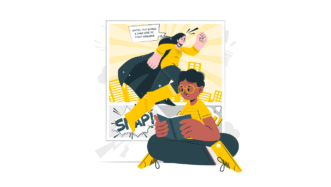LESSON OVERVIEW
The main objectives of this lesson are to:
- read and discuss an article about Gen Z’s preference for sad music;
- learn vocabulary for describing sad music and listener behaviour;
- talk about changes in music trends in recent years.
With this lesson, students read and discuss an article about Gen Z’s preference for sad music. They discuss the titles of popular Spotify playlists and learn the vocabulary to describe sad music and listener behaviours (e.g. melancholy lyrics, wallow). They discuss sad songs they know, analyse comments, and share opinions. They talk about changing music trends, answer questions, and complete statements with their own ideas.
45 minCritical Reading ClubUnlimited Plan
This is a Critical Reading Club worksheet. With this format, students need to read an online article at home and do the exercises in the classroom. Learn more about how to use such worksheets and their benefits in our post.
ACTIVITIES
This CRC lesson asks students to read and discuss an article about Gen Z’s preference for sad music. The lesson begins with a warm up in which students look at the names of popular Spotify playlists (e.g. ‘Sad Girl Summer’, ‘Comforting Sad Mix’) and discuss related questions. Next, they do a vocabulary exercise in which they complete sentences about listener behaviour with words and phrases to describe sad music (e.g. resonate with, stripped-back sound). Then, they practise the vocabulary further by thinking of specific songs the words and phrases apply to. After that, they analyse some comments about Gen Z’s preference for sad music and give their own opinion. Following that, they read about some changes in music trends (e.g. song length, genre popularity) and answer some questions about the information. Lastly, students complete statements related to music with their own ideas.
ARTICLE
Subscribe to unlock these and many other Standalone lesson lesson plans with the Unlimited planWORKSHEETS
















‘Latinx’ is a nonsense term used exclusively by White liberals. It doesn’t make sense in the Spanish language and Latino people pretty much universally hate this White anglophone imposition on their language.
FYI: The article no longer exists, sadly. I’m unable to use this lesson now due to that fact – what a shame!
Hey, thanks for letting us know about this! We found an alternative source so hopefully you can still do the lesson 🙂
Amazing! Thanks for the quick fix and response 😀
Very welcome!
Hey, is it only me or the article website doesn’t exist anymore ?T_T
Hi! It seems to work fine, so check it again, but if you still have a problem, contact us at [email protected].
The article wasn’t working again, even bypassing the paywall. I found it here https://www.thealbertan.com/ontario-news/the-music-subgenre-sadcore-finds-a-new-life-with-a-new-generation-6227956
Thanks for sharing it with us! We’ve replaced the link. Hope that helps 🙂